More than 90% of criminal investigations now involve a digital footprint, whether it’s a suspect’s social media trail, smartphone metadata, or hidden online transactions. Digital clues are no longer the exception; they’re the rule. In 2023, INTERPOL reported that cyber-enabled crimes had surpassed traditional offenses in several regions, shifting the frontline of law enforcement to the digital domain.
Consider the 2020 kidnapping case in Ohio. Traditional leads had dried up, but the deleted Snapchat location history helped trace the suspect’s last known position, an abandoned warehouse. Digital breadcrumbs cracked the case, reshaping how law enforcement handles investigations. In the digital era, officers must evolve or risk falling behind.

What Is OSINT for Law Enforcement?
Open-Source Intelligence (OSINT) refers to publicly available information that is collected, processed, and analyzed to meet a specific intelligence need. For police and investigators, OSINT includes social media content, public records, forums, digital marketplaces, and geospatial data.
Unlike covert surveillance or classified intelligence, OSINT is sourced in a legally and ethically sound manner. It helps law enforcement bypass bureaucratic hurdles, act quickly, and support investigations with real-time insights that are legally defensible.
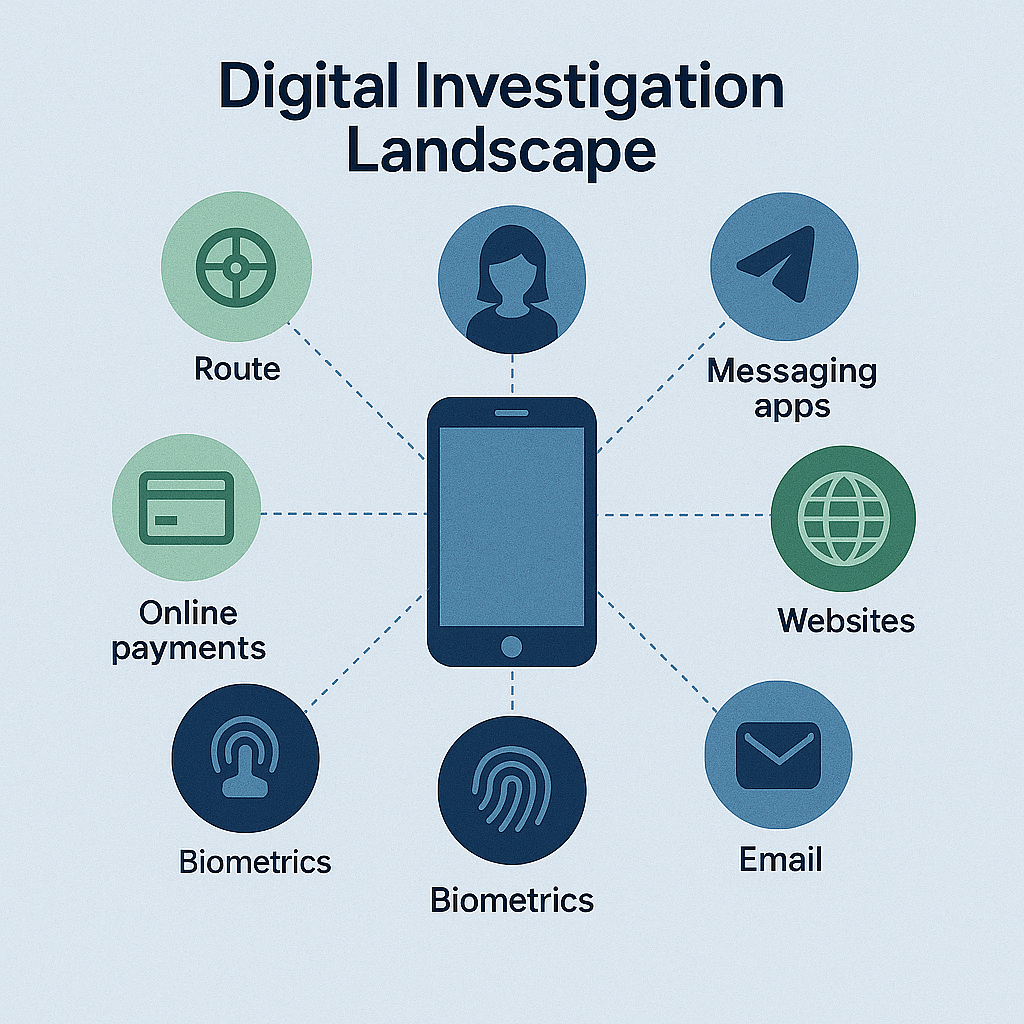
How to find Hidden Profiles using Google dorking
A username alone can lead to dozens of online profiles if you know how to search smart. Law enforcement officers often use Google search operators (“Google dorking”) to uncover aliases on forums, social media, and news mentions buried from plain view.
Try queries like:
intitle:”prfile” site:facebook.com “ghostwolf_72”
inurl:/user/ “ghostwolf_72”
These will return profile pages or forum threads associated with a specific alias across indexed sites, without needing access to private databases.
Why Police OSINT Is Now Essential
With the increased availability of publicly available data, relevant intelligence is already out there waiting to be discovered. Without structured OSINT workflows and modern tools, police departments face:
- Slower case resolution
- Inefficient use of time and resources
- Missed indicators of criminal activity
Criminals are adapting. They use encrypted messaging apps, throwaway usernames, and anonymous online platforms. OSINT helps officers remove the blindfold and gain visibility.
Key Categories of Open Source Information for Law Enforcement
Law enforcement professionals should be fluent in a wide range of open-source categories:
1. Public Records
Public records include court filings, arrest logs, corporate registries, property deeds, and voter rolls. These are essential for conducting background checks, tracing financial flows, and linking suspects to known addresses, businesses, or assets.
2. Media
News articles, both local and international, can reveal details about ongoing cases, timelines, and community responses. Press releases and public safety announcements may also identify persons of interest or corroborate official statements.
3. Internet
This broad category encompasses:
- Websites & Blogs: Monitoring fringe blogs, extremist sites, or hate speech hubs helps detect early-stage radicalization or calls to action.
- Social Media: Platforms like Facebook, TikTok, LinkedIn, X (formerly Twitter), and Telegram often hold the first clues, such as photos, event attendance records, or network connections.
- Forums & Message Boards: Sites like Reddit, 4chan, and regional discussion boards can surface criminal bragging, planning activity, or trend signals.
- Dark Web: With proper legal authority and expertise, monitoring dark web marketplaces and forums can uncover illicit trades in weapons, drugs, or stolen data.
- Classifieds & E-commerce: Craigslist, eBay, and Facebook Marketplace are frequently used to sell stolen goods, launder funds, or advertise services associated with fraud or human trafficking.
- Geospatial Data: Includes satellite imagery, mapping platforms, and geotagged social posts. These tools are powerful for locating suspects, identifying hideouts, or analyzing movement patterns around a crime scene.
- Academic and Grey Literature: Think tank reports, research studies, leaks, and underground publications can provide context on threat actors, ideological shifts, or technical methods in use (e.g., new encryption techniques or fraud tactics).
Example: In a trafficking investigation, satellite images were used to detect unusual warehouse activity near the US-Mexico border, which was cross-validated with TikTok videos geotagged in the same area.
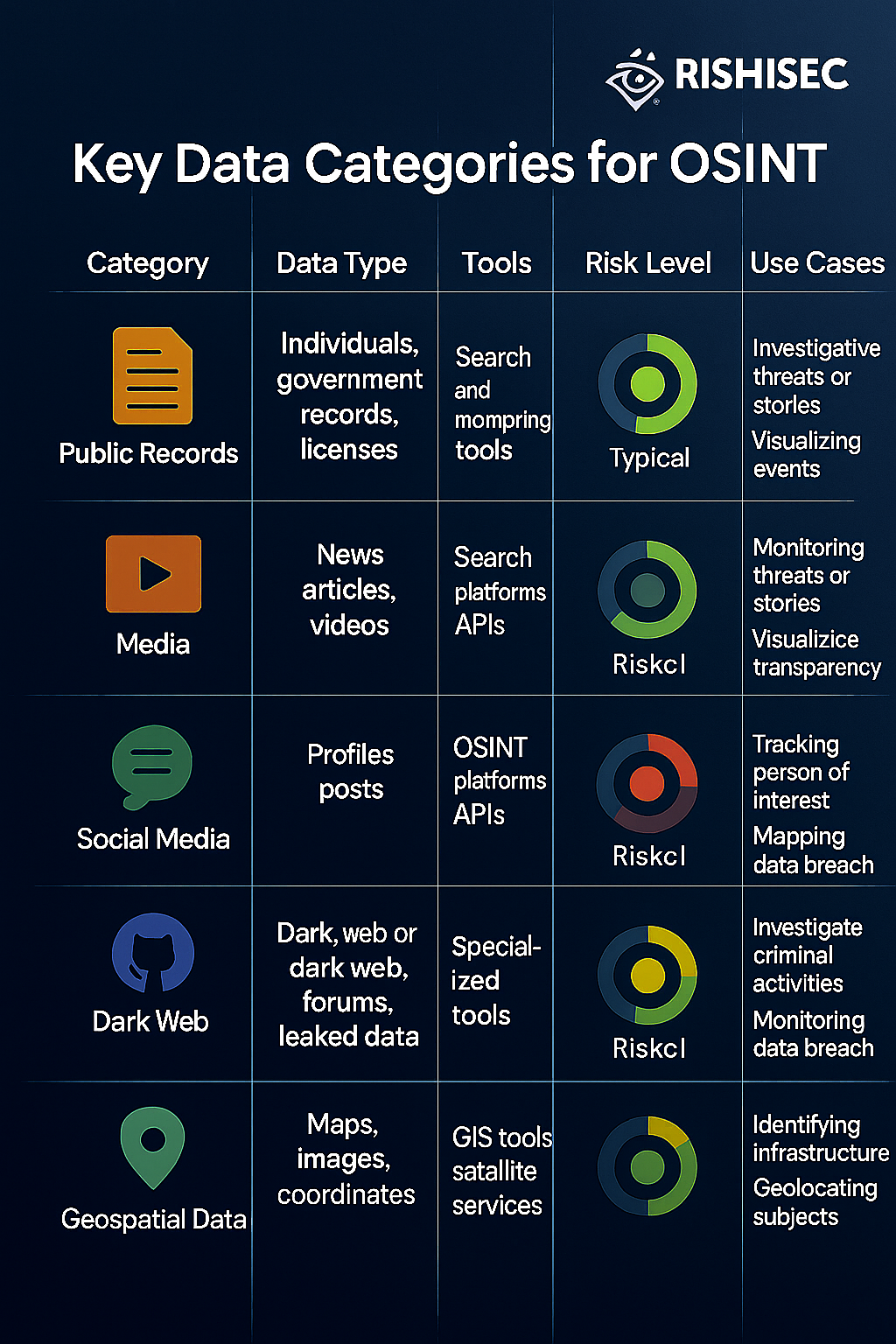
Open Sources
The OSINT Lifecycle: A Strategic Framework for Investigators
Open-source intelligence isn’t just a tool for investigators; it has a structured cycle that guides law enforcement from investigation planning to actionable insight. Understanding and applying each phase of the OSINT lifecycle ensures maximum value from every digital source.
1. Planning & Direction
Every effective investigation begins with a clear question. What are you trying to uncover: identity, location, or affiliations?
- Define the intelligence objective (e.g., locate a missing person, verify a suspect’s social presence).
- Prioritize key data points based on the urgency and relevance of the case.
2. Collection
Once objectives are set, analysts begin gathering data from public domains. This phase must be focused on to avoid irrelevant noise. For example, if a suspect’s alias is found in a crime report, investigators can run it across 100+ platforms using tools like WhatsMyName to map out a digital footprint
- Sources include forums, social media, public records, news archives, marketplaces, and other relevant platforms.
- Utilize automation tools like Kindi to streamline collection and identify connections between usernames, emails, and content across various platforms.
How to Track a Username Across Platforms
If a suspect uses a unique alias, you can trace their digital presence using tools like WhatsMyName.
Steps:
- Enter the handle (e.g., @sus_handle)
- The tool checks the alias across 100+ platforms, including Reddit, TikTok, Discord, and Telegram.
- It returns any found matches, complete with profile links.
Screenshot and store these results for later correlation or use in warrant prep.
3. Processing & Exploitation
Raw data often comes in disorganized formats, such as text, images, foreign languages, or screenshots. Processing makes it usable.
- Translate non-English content
- Extract metadata (location, timestamps)
- Organize assets into searchable case files
4. Analysis & Production
This stage is where data becomes insight. Analysts compare data across platforms, validate identities, and build narratives.
- Identify digital patterns and timelines.
- Create network graphs and relationship maps.
- Test behavioral hypotheses
5. Dissemination & Integration
Intelligence must be delivered securely and in a format that supports operational action.
- Share reports with supervisors or task forces
- Integrate findings into larger case files or prosecution briefs.
6. Feedback & Evaluation
After-action reviews are essential. Evaluate what worked, what didn’t, and how to improve future cycles.
- Did OSINT help close the case?
- Were tools and workflows efficient?
- What gaps need addressing?
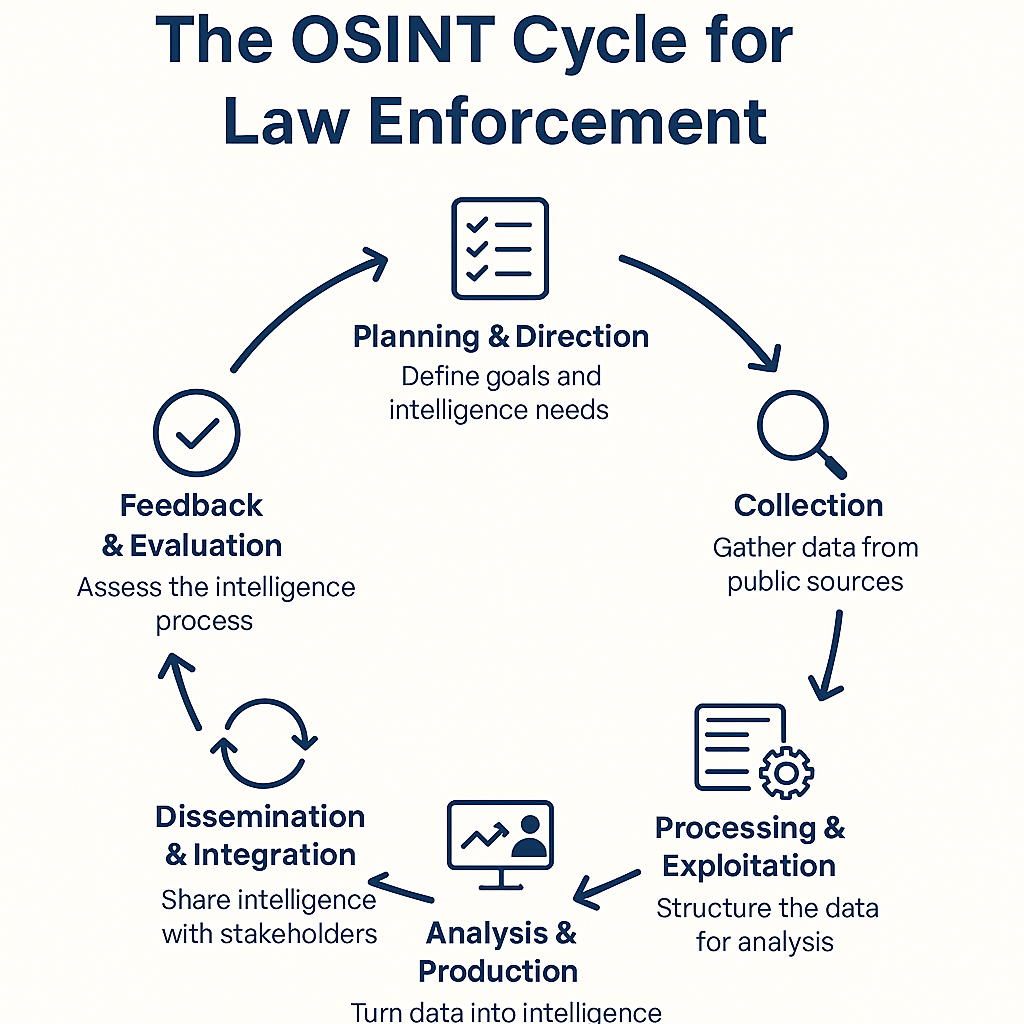
How to Trace Location with Image Metadata
Suspects often upload images that include GPS data. Use a tool like ExifTool to extract metadata:
bash
Copy code
exiftool suspect_photo.jpg
Look for:
- GPS coordinates
- Timestamp
- Device info
Cross-reference coordinates with maps or known locations to verify presence at a crime scene.
OSINT Tools for Law Enforcement
Modern investigations demand digital expertise. Law enforcement officers now rely on OSINT tools to trace suspects, validate locations, analyze networks, and uncover hidden digital evidence.
- Alias & Identity Tracing: Track usernames, emails, and phone numbers across platforms to uncover connected profiles and infrastructure.
- Location Verification: Utilize tools like ExifTool and satellite imagery to extract geotags and verify locations from photos and videos.
- Social Media Intelligence: Monitor public posts, recover deleted threads, and use search operators for targeted content discovery.
- Link and Network Analysis: Build visual timelines, map relationships between entities, and identify key actors in criminal networks.
Kindi, RishiSec’s AI-powered link analysis tool, brings all of this together. It includes automating data correlation, building actionable intelligence, and delivering real-time visual insights to help officers act fast and smart.
High-Impact OSINT Use Cases in Law Enforcement
Open-source intelligence (OSINT) is reshaping modern policing. From violent crimes to counter-terrorism, OSINT enables law enforcement to uncover patterns, track digital footprints, and validate physical leads faster than ever.
Below are real-world case-style examples of how OSINT empowers different areas of law enforcement.
A. Violent Crime Investigations (Homicide, Assault, Robbery)
Detectives use OSINT to reconstruct events, identify suspects, and verify alibis.
- Case Example – Robbery Case in Houston:
Instagram photos and Facebook check-ins helped place a suspect near a gas station minutes before a robbery. The clothing in the selfie matched the surveillance footage.
B. Missing Persons & Child Exploitation
Speed is critical. OSINT helps trace online activity and spot behavioral red flags.
- Case Example – Child Exploitation via Telegram:
A cybercrime task force identified a group distributing illegal content by correlating usernames with offender registries. Multiple arrests followed.
Tool Tip: TikTok geolocation data and username trackers, such as Sherlock or WhatsMyName, accelerate early trace work.
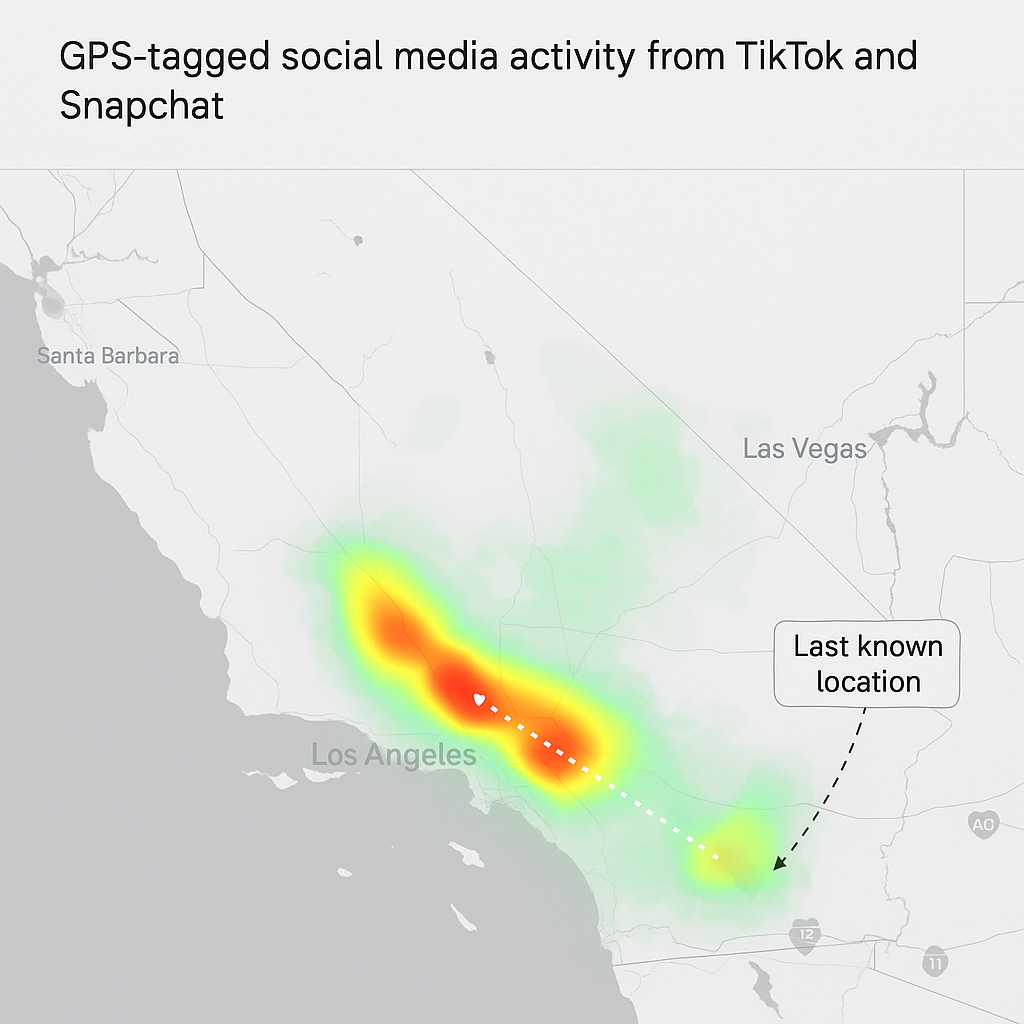
Tracking a Missing Teen’s Movements via TikTok GPS Data
C. Gangs, Narcotics, and Organized Crime
Criminal networks operate online using encrypted apps and coded language.
- Case Example – Miami Fentanyl Ring:
In Chicago, gang analysts used link analysis to trace connections between suspects involved in drug trafficking. Public Instagram activity and mutual followers revealed a network structure aligned with field intelligence.
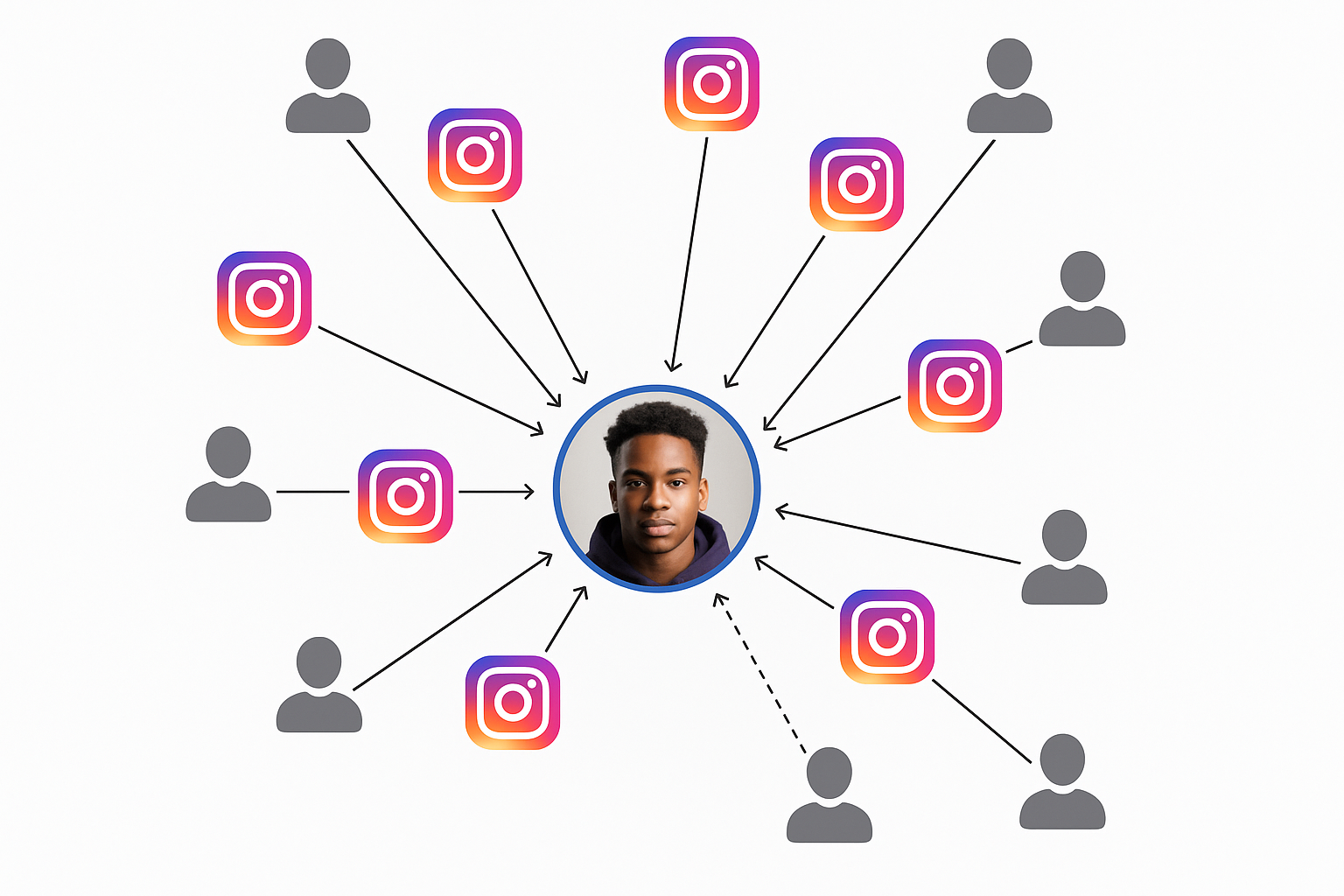
Visualizing a Criminal Network Through OSINT Link Analysis
D. Counter-Terrorism and Extremism
OSINT helps detect radicalization early and trace propaganda.
- Case Example – UK Extremist YouTuber:
A creator spreading violent ideologies was linked to an extremist network using IP matching and Telegram surveillance.
E. Financial Crimes & Asset Forfeiture
- Case Example – Influencer Tax Evasion:
An influencer flaunted wealth on social media that didn’t match reported income. OSINT linked luxury purchases and travel to undeclared assets.
F. Cybercrime Investigations
OSINT supports attacker profiling and infrastructure mapping.
- Case Example – Dark Web Ransomware Ring:
Following a healthcare ransomware incident, dark web posts selling patient data were linked to aliases from previous breaches.
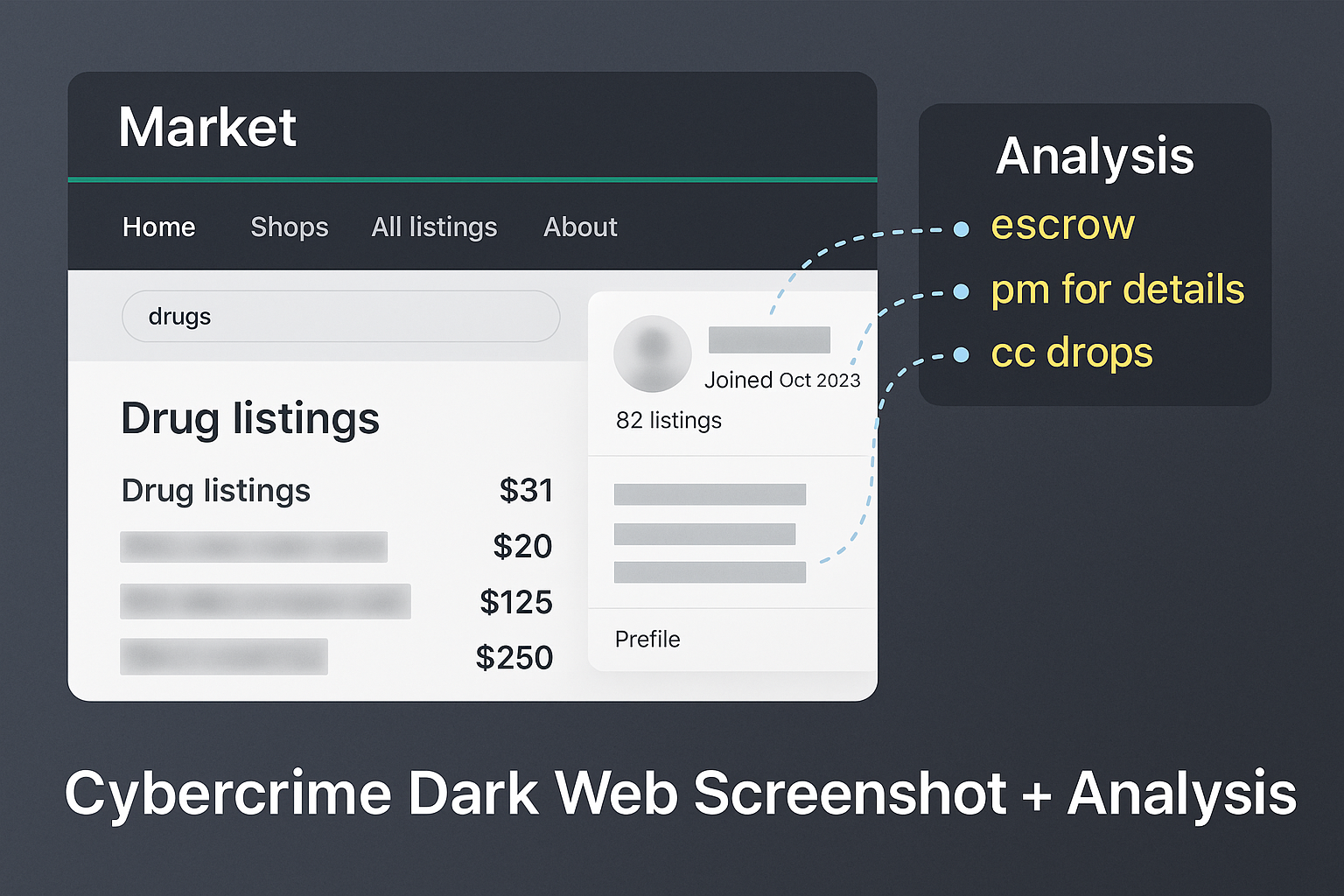
Dark Web Screenshot with Language Pattern Analysis
How to Monitor Dark Web Forums
Dark web forums often advertise data dumps, illicit software, or trafficking services. With proper authorization, investigators can monitor these spaces using Tor Browser and search tools like Ahmia.
Tips:
- Use a secure, sandboxed environment
- Search for key terms related to the case (e.g., victim names, stolen data, ransomware group aliases)
- Capture screenshots as evidence—do not interact with threat actors
Legal and Ethical Considerations in Police OSINT
Open-source doesn’t mean open season. Law enforcement must follow strict protocols to ensure OSINT evidence holds up in court and respects civil liberties.
- Privacy Laws: Jurisdictions differ in their treatment of public data. For example, U.S. officers may collect publicly posted social media content without a warrant, but European GDPR rules impose stricter limitations. An effective police OSINT program must align with local data protection frameworks and regulations.
- Chain of Custody: OSINT findings used in court must follow strict evidence handling protocols. This evidence includes timestamping, logging of access, and maintaining a verifiable audit trail to ensure digital evidence remains admissible and defensible.
- Terms of Service: Many platforms explicitly prohibit scraping or automated data collection in their terms of service. Violating these agreements can compromise both the admissibility and credibility of the agency in legal proceedings.
- Policy and Procedure: Agencies should develop written Standard Operating Procedures (SOPs) for OSINT collection. These guidelines should include specifications on permissible tools, data retention policies, report formatting, and procedures for supervisory review.
Analysts must combine technical skill with sound judgment. The line between public and private can blur quickly online. For a deeper look at how open-source intelligence intersects with civil liberties, ethical reporting, and investigations beyond law enforcement, check out our guide on OSINT for Journalists and Human Rights Organizations.
It explores how activists, journalists, and investigators ethically navigate open data to expose abuses, verify claims, and protect sources.
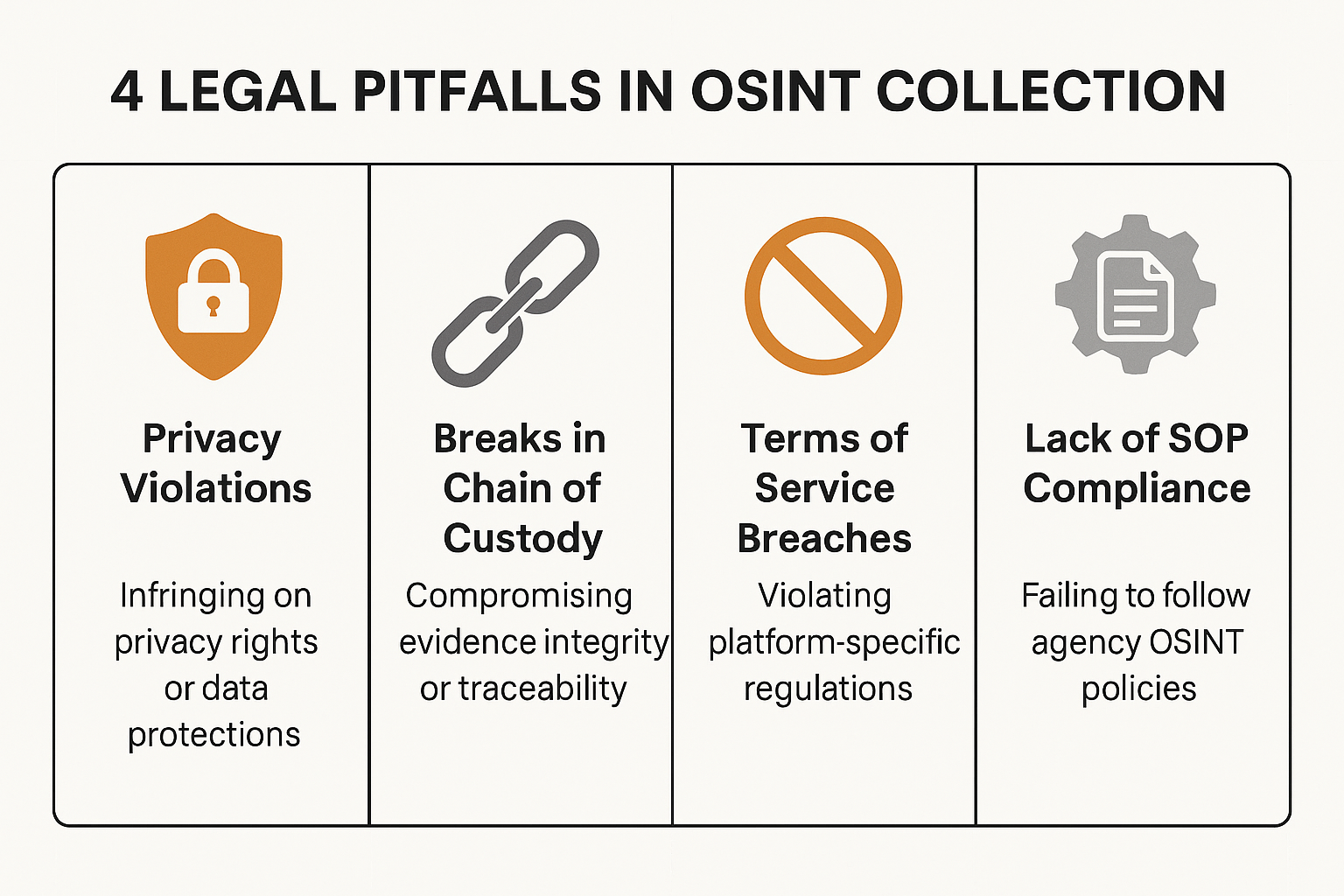
How to Perform Link Analysis Using Kindi
Kindi is an AI-powered link analysis tool built for OSINT law enforcement professionals.
Steps:
- Upload usernames, IP logs, and screenshots
- Kindi auto-links social profiles, devices, and message threads.
- Generates visual graphs and case timelines
- Exports court-ready reports with complete source documentation
Kindi is especially powerful for uncovering relationships in trafficking, financial fraud, or gang networks.
The Analyst’s Mindset: Essential Traits for OSINT Success
Effective open-source intelligence gathering isn’t just about having the right tools; it’s also about understanding how to utilize them effectively. It’s about cultivating the right mindset. The most successful OSINT professionals bring a combination of critical thinking, creativity, and ethical discipline to every investigation.
- Curiosity & Persistence
The best investigators follow digital trails relentlessly, chasing connections across platforms and sources until a complete picture emerges. They ask the following question, and then the next one. - Analytical Thinking
Surface data isn’t enough. Analysts must assess credibility, identify bias, and correlate fragmented inputs into cohesive intelligence products. - Ethical Rigor
Knowing where the legal and ethical boundaries lie is crucial. Analysts must strike a balance between investigative value and public trust and privacy rights. - Creativity
Sometimes, the best leads come from an unexpected angle. Skilled investigators know how to pivot search strategies and explore unconventional data sources. - Patience
OSINT often involves long hours sifting through irrelevant, messy, or misleading data. Methodical discipline is key to separating signal from noise.

Traits of a good analyst
Implementing OSINT in Law Enforcement Workflows
To truly integrate OSINT into operational workflows, agencies must treat it as a strategic capability, not a one-off resource. Steps include:
- Designate OSINT Officers or Teams: Identify and train personnel whose primary focus is gathering digital intelligence and conducting open-source investigations.
- Embed Analysts into Operational Units: Integrate OSINT professionals into detective squads, cybercrime teams, and digital forensics labs to ensure data is acted on quickly.
- Assign Structured Roles: Clarify responsibilities for collection, triage, analysis, and dissemination. This clarification enhances accountability and facilitates workflow optimization.
- Invest in Training and Certification: Prioritize formal training through accredited providers like SANS, McAfee Institute, and OSINT Combine. Support ongoing development in tools, legal updates, and ethical practices.
- Adopt an Investigation Stack: Combine tactical OSINT tools, such as Kindi, with workflow automation and case management platforms. This helps standardize and scale digital investigation efforts.
- Integrate with Existing Protocols: Ensure OSINT teams collaborate with criminal intelligence units, prosecutors, and forensic experts to facilitate seamless integration and information sharing. This ensures chain of custody, courtroom admissibility, and investigative alignment.
- Measure Impact: Track key metrics, including leads generated, cases expedited, and hours saved. Utilize after-action reviews to continually improve techniques, tool selection, and workflows.
Conclusion
Today’s investigations are won not just in the field, but in the data. As digital footprints become as critical as fingerprints, Open-Source Intelligence (OSINT) has become indispensable to law enforcement. From missing persons and cybercrime to gang networks and financial fraud, this guide has demonstrated how OSINT enables agencies to act more quickly, uncover more information, and build stronger cases.
However, OSINT is only as effective as the tools behind it. That’s where Kindi, RishiSec’s AI-powered link analysis platform, plays a vital role. Kindi automates link mapping, timeline construction, and network visualization, making complex digital investigations easier, faster, and more accurate. To learn how to apply everything in this blog with hands-on labs, real-world examples, and tools like Kindi, sign up for our FREE OSINT for law enforcement course. Ensure that your digital investigative capabilities are modernized before the next critical clue is missed.




